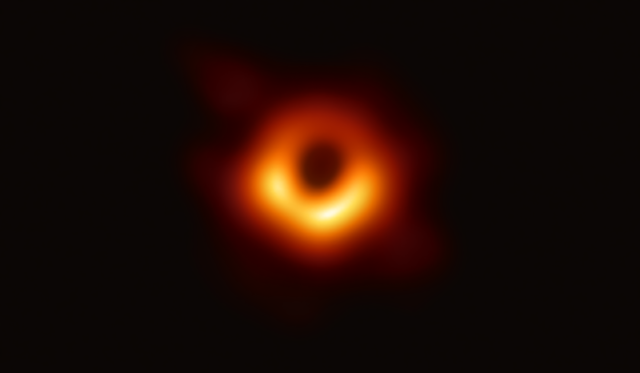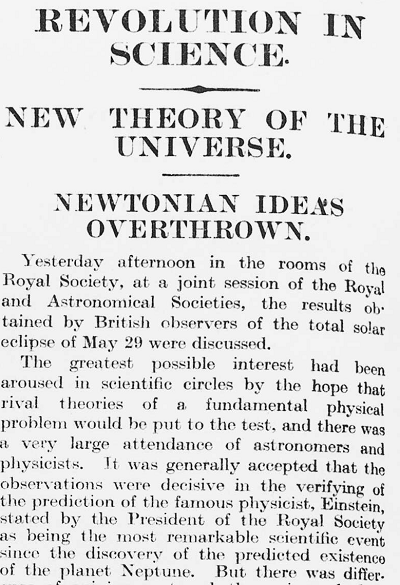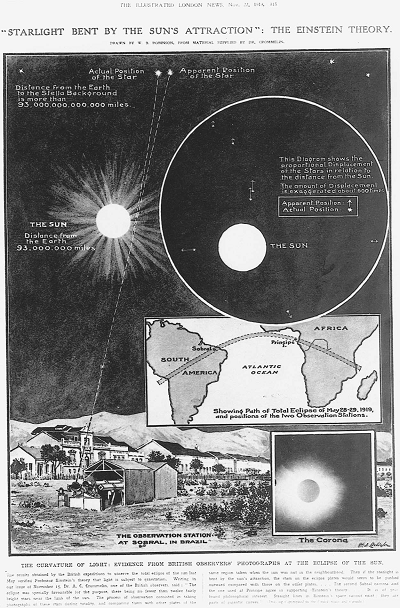The spreading of science news, from Arthur Eddington (1919) to black holes (2019).
Author: Jaume Navarro is an Ikerbasque Research Professor at the University of the Basque Country

On April 10th 2019, the Event Horizon Telescope project released the first image ever of a black hole. Five simultaneous press conferences, in Brussels, Taipei, Santiago de Chile, Tokyo and Washington were broadcast live, staging a global media event for astrophysics. Besides the inevitable memes in the so-called social media, more serious press outlets managed to transmit two main ideas: the international character of the research project and, as it often happens, that this scientific achievement could be traced back to Einstein. None of this was offhand. The campaign was prepared much in advance so as to make the headlines and have the image on the front pages of newspapers and open news bulletins on television. Moreover, at a time when internationalism is challenged in the global political arena, the collaboration of teams of scientists around the globe to produce this image was an aspect to be emphasised. “Einstein was right”, so the headlines went, and “global, collaborative science has so proven”.

One hundred years ago, in November 1919, a similar event took place at the Royal Society in London with some elements that resonate with the current black hole frenzy. The headline on the front page of The Times “REVOLUTION IN SCIENCE. New theory of the universe. Newtonian ideas overthrown” captured the public imagination together with images of the sun during an eclipse. The occasion was the astronomical expeditions to Sobral, in the north of Brazil, and the island of Principe, in the Gulf of Guinea, to observe the behaviour of light from distant stars in passing next to the sun during a total eclipse. The photographs the two teams of astronomers obtained were transformed into the experimentum crucis that proved General Relativity and enthroned Einstein as the new Newton.
The British astronomers Arthur Eddington, head of the Cambridge Observatory, and Frank Dyson, the Astronomer Royal, headed the project aimed at evaluating one of the most dramatic predictions of an esoteric physical theory formulated during the Great War by Albert Einstein, a German physicist still unknown to the general public. General Relativity was a radically new theory of gravitation that only a handful of theoretical physicists could seriously understand, not only due to its mathematical complexity and conceptual originality but also because it had been formulated during the War. Among its consequences, the prediction of a very specific and computable diversion of the path of light in the presence of huge gravitational masses was particularly striking. The possibility of measuring such bending of the light from distant stars during an eclipse and to use it as a test of the theory moved the astronomical expeditions.
But there was more to it. The war had erased the German, the Austro-Hungarian and the Ottoman empires and the losers were relentlessly held accountable for the war. Scientists were not alien to such nationalistic and vindictive climate: those from the axis were excluded from academic meetings and many key scientists from the allied nations cancelled their subscriptions to German journals. Nationalism and resentment were taking control of science, both professional and popular, in spite of its supposed claim to universalism.
The British astronomical expedition tried to stay away from this atmosphere and was designed to help heal the wounds of the war. Arthur Eddington was one of the few British mathematicians able to understand Einstein’s theory and he was also a Quaker and a firm believer in pacifism and internationalism. Thus, he not only was one of the first astronomers to sense that General Relativity could be tested with the eclipse results, but also that the proof by British astronomers of a German theory could be a first step towards peace in science and politically. To that end, the results had to be advertised as much as possible and, more importantly, they should appear clear and irrefutable to the public.
As a number of historians of science have shown, the observations were far from conclusive. Most pictures were blur and difficult to assess. Bad weather and faulty instruments were responsible for a number of useless photographs. Those that could be analysed were pale and, thus, complex to interpret. Only in retrospect can they be considered an experimentum crucis and used as a major case sudy by Popperian philosophers. This is not to say that the results were forged in any way. No. But in their interpretation, and eager to turn their expeditionary project into a turning point event, Dyson and Eddington created a ‘false trichotomy’. Their starting point was that their observations could only have three results: either light from the star had no bending whatsoever, it did, but following Newtonian laws, or the deflection was twice as much as the predicted in Newtonian terms and, therefore, proving Einstein’s theory. No picture gave exactly that figure and, in average, the results were somewhat in between Newton and Einstein’s predictions, only closer to the latter than the former. Only with the a priori ‘false trichotomy’ in mind could such results be considered conclusive, taking out of the picture any other possible interpretation.
The astronomical expeditions, the eclipse and the importance of this event were highly publicised by Eddington and Dyson via their contacts with The Times, thus creating a climate of expectation, an anticipatory mood that something big was about to happen. This was an opportunity to popularise theoretical physics and astronomical work as well as to portray the missions to Principe and Sobral in pair with, for instance, Charles Darwin’s voyage with the Beagle or Robert Falcon Scott’s failed expedition to the South Pole. Thus, when the Royal Society and the Royal Astronomical Society announced an unusual joint meeting for November 6th, 1919, the climate was ripe for the big news.
Sir Joseph John Thomson, former director of the Cavendish Laboratory and, by then, master of Trinity College had served as president of the Royal Society during the war years and he was now in charge to organise and preside over the momentous meeting. As a matter of fact, two weeks earlier, Eddington had announced the results at a private meeting in Cambridge with the most influential physicists of the moment. Thomson was probably among the attendees or, at least, knew about the outcome in advance to the meeting in London. The mathematician and philosopher Alfred North Whitehead gives us a first-hand account of the joint meeting: “The whole atmosphere of tense interest was exactly that of a Greek drama: we were the chorus commenting on the decree of destiny as disclosed in the development of a supreme incident. There was dramatic quality in the very staging: the traditional ceremonial, in the background the picture of Newton to remind us that the greatest of scientific generalisations was now, after more than two centuries, to receive its first modification”.

The “revolution in science” was not challenged. Eddington and Dyson had paved the way to an unproblematic acceptance of their results and their interpretation, as well as Einstein’s law, even though in private they acknowledged that more tests and observations were needed before fully accepting those results. Even Sir Oliver Lodge, another of the great names in physics, when cautioning about the possible rushed extrapolations of the announced results did not hesitate to admit that the “eclipse result is a great triumph for Einstein” and to congratulate him “and also the skilled and painstaking observers who have so admirably verified his striking and original prediction”.
“Light caught bending” announced the Daily Mail as The Times was talking about a “Revolution in Science”. The New York Times went for “Einstein Theory triumphs” when news arrived to the US. Interestingly, as it often happens with science news, it was members of the Royal Astronomical Society, not journalists who fed the media with the news, their interpretation and their relevance. Thus, Eddington could promote his preferred vision of the episode and give it the internationalist and pacifist twist he wanted, as well as using it to spread a theory that would become a sign of esoteric modernity and triggering the creation of Einstein as an icon of science.
References:
Collins, H. and Pinch, T. (1993) The Golem: What Everyone Should Know About Science, Cambridge: Cambridge University Press, ch. 2.
Sponsel, A. (2002) ‘Constructing a ‘Revolution in Science’’, British Journal for the Historybof Science 35: 439-467.
Stanley, M. (2003) ‘An Expedition to Heal the Wounds of War: The 1919 Eclipse and
Eddington as Quaker Adventurer’, Isis 94: 57-89.
To celebrate this centenary, the Paris Observatory has organised an international meeting in May this year.